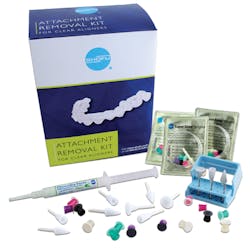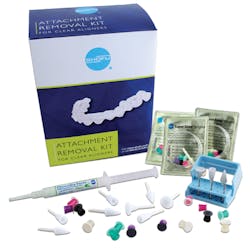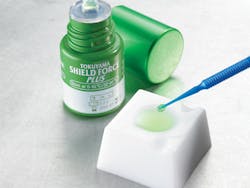Pearls for Your Practice
Joshua Austin, DDS, FAGD, reviews the Attachment Removal Kit for Clear Aligners from Shofu Dental Corp., the QuickSplint interim dental splint from Orofacial Therapeutics LP, and the Shield Force Plus desensitizer from Tokuyama Dental Corp.
Attachment Removal Kit for Clear Aligners
by Shofu Dental Corporation
Clear aligner systems have been a great advancement in orthodontics for both dentists and patients. We now have the ability to correct simple orthodontic issues discreetly with the aid of sequential clear aligners. Having worn Invisalign myself last year, I can tell you that the most annoying part of the whole process was the attachments, or buttons. They can be tedious to put on and finish. They tend to rub the inside of the lip, and they can be a perfect trap for plaque and food debris. As a clinician, taking the attachments off always makes me nervous. I want to make sure that I get the entire attachment off, but I don't want to damage the underlying enamel at all.
In the past, I used a 12 or 20 fluted-carbide finishing bur to remove the attachments and followed that with any number of single-point polishers to buff the enamel. The problem with this method is potential damage to the underlying enamel. Obviously, once enamel is gone, it's gone for good. Thinking about this led me to look for other options for attachment removal.
The Attachment Removal Kit for Clear Aligners by Shofu Dental Corporation has made this much easier. It has everything you need to safely remove attachments for all of your clear aligner cases.
Starting with a pencil, outline the edges of the attachment on the tooth. Use the black Super-Snap disc or a Robot Carbide CTF-FG Finisher to remove the bulk of the attachment. This should be done at a slow speed-approximately 10,000 rpm. After two-thirds or so of the attachment has been removed, switch over to the OneGloss single-step polisher using light pressure at 10,000 rpm until the pencil marks are completely gone.
OneGloss points, cups, and discs are included in the kit for added flexibility. Just pick the best one for the area you are working on! For sequential polishing, Shofu has also included Super-Snap discs of different grits in the kit. The kit also comes with a nice bur block, along with some Beautifil II and Beautifil Flow Plus flowable composite for placing the buttons-a great added value.
Shofu makes some of the best finishing and polishing products on the market. I have written about several of these products in the past because they have always worked well for me. While you will definitely find that black Super-Snap discs, Robot Carbide Finishers, and OneGloss polishers are the three go-to products in the kit, the kit is all-inclusive: It has everything you might need to remove attachments in a safe, minimally invasive way. Line-drive single to left field for Shofu!
QuickSplint
by Orofacial Therapeutics LP
Every month, I see a few emergency patients who present with orofacial pain, and nothing is more annoying. I am not a TMD specialist, but I can usually weed out those with orofacial pain versus those with TMD. When a patient comes in complaining of orofacial pain, we don't have much to offer. A soft diet, NSAIDs, and a hot, moist compress are typically of little solace to a patient in pain looking for a solution. Many of these patients need an equilibrated occlusal splint, but that takes lab time to turn over. Having something in your back pocket that your patient can leave with can make you a hero to them. QuickSplint is a great option for that!
QuickSplint is a prefabricated anterior splint that is relined chairside for a custom fit. Using a fast-setting polyvinyl siloxane (PVS) material like a bite registration, QuickSplint can be fitted and customized in less than five minutes.
QuickSplint works like a wide-span anterior deprogrammer to allow for muscle relaxation and pain relief. Like most anterior deprogrammers, QuickSplint is best when used as an interim solution. For four to six weeks, QuickSplint can offer pain relief while your laboratory fabricates a full splint. QuickSplint can also be used diagnostically. After a few weeks of wear, parafunctional activity will leave marks on the QuickSplint, so you can visualize the patient's habits and customize your treatment plan.
The real win is being able to offer your patients a solution for orofacial pain quickly. Patients appreciate immediate solutions to pain issues, and by using QuickSplint, you can win some raving fans. You could incorporate the low cost of QuickSplint into your occlusal splint fee, or you could charge separately for it. Patients in pain would be willing to pay for immediate relief.
Another great use for QuickSplint is during the provisional phase of more sophisticated anterior dentistry. If you have a patient in anterior provisionals for any amount of time, you want to ensure that they don't break. Having the patient wear a QuickSplint during this time can protect your temps and give you some peace of mind. I've used QuickSplint for this purpose multiple times over the past couple of months.
As I said before, my practice is not limited to TMD and orofacial pain. Treating TMD and orofacial pain is a very small part of what I do. Even so, QuickSplint has filled a small hole in my toolbox by enabling me to quickly fabricate devices to help patients with orofacial pain while the lab makes their custom splints-and I've found a few other uses for it too. QuickSplint absolutely has a place in my practice. Hard-hit double in the power alley for Orofacial Therapeutics!
Shield Force Plus
by Tokuyama Dental Corp.
Dentinal hypersensitivity is something I deal with on a daily basis in my practice. I don't think I practice on some sort of surreal hypersensitivity island, so my guess is that most other dentists deal with the same things I do. The other day, I had a patient in for hygiene recall who was complaining of sensitivity to cold, specifically during her nightly tradition of eating an Eskimo Pie. During the prophy, my hygienist found the spot. The hypersensitivity was coming from 0.5-1.0 mm of gingival recession on tooth No. 20. When I blew air on it or rubbed an explorer on it, she lit up. The interesting part was that No. 31 had approximately 3 mm of gingival recession. Why was the small amount of recession on No. 20 more sensitive than No. 31, which had a much larger defect? That's a complex question with a multifactorial answer, but it boils down to the fact that the larger defect had been present longer; therefore, the dentinal tubules had been occluded over time by an array of products and secondary dentin. Meanwhile, No. 20 was fresh, meaning those exposed dentin tubules were very sensitive.
We decided to try an application of Shield Force Plus, and my patient felt immediate relief. She was thrilled-and that thrilled me. This opened my eyes to Shield Force Plus. Having a product like this around can make a lot of patients really happy.
The process of applying Shield Force Plus is incredibly simple. It takes less than 30 seconds. Simply dry the affected area and apply a thin coat of Shield Force Plus for 10 seconds. Air thin with weak air for 5 seconds and then with strong air for 5 more seconds. Light cure for 10 seconds, and you're done.
Shield Force Plus can also be used to prevent sensitivity on direct and indirect restorations. For direct restorations, apply Shield Force Plus (the same way as described above) after the preparation. Once that's done, start your bonding process. Just make sure to do your etching step after the Shield Force Plus has been applied and cured. You are probably asking yourself what kind of effect this has on bond strength. Tokuyama has data to show that it does not diminish bond strength, which is good news. It can also be used under indirect restorations to eliminate postoperative sensitivity.
I think Shield Force Plus is a handy material to have around the office to help patients with hypersensitivity. All too often, we fall into the rut of only offering slow solutions for sensitivity, such as dentifrices. Offering an immediate and noticeable solution for hypersensitivity can be a great relief for our patients. Line-drive single to left field for Shield Force Plus!



